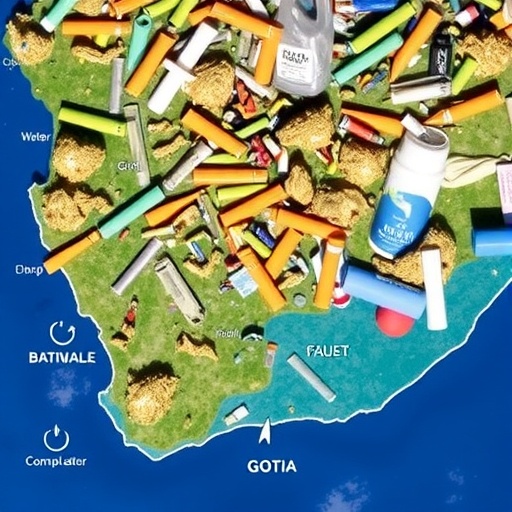In recent years, the pervasive presence of microplastics in various ecosystems has garnered significant attention from researchers, environmentalists, and the public alike. A recent study conducted in a Lowveld city in South Africa has shed light on the contamination of municipal water systems with microplastics. This research, which focuses on analyzing the variations of microplastic contamination in water sources, is a crucial step toward understanding the implications of this environmental issue on public health and policy.
Microplastics, defined as plastic particles less than five millimeters in size, pose a significant threat to both aquatic and terrestrial ecosystems. Their microscopic nature makes them nearly invisible to the naked eye, thus complicating detection and management efforts. The introduction of these pollutants into the municipal water supply raises concerns not only regarding environmental degradation but also concerning the potential human health risks associated with consuming contaminated water.
The study conducted by researchers, including Dalu et al., aims to reveal the extent of microplastic pollution in municipal water systems. By systematically measuring microplastic levels across various locations within a Lowveld city, the research team has utilized innovative techniques to determine contamination levels. Their approach involved rigorous sampling and analysis methods, underscoring the seriousness of the microplastic crisis that has been steadily escalating around the globe.
One of the most alarming findings from this study is the variation in microplastic contamination levels across different sites within the city. This heterogeneity suggests that local environmental factors such as proximity to industrial areas, urban runoff, and wastewater discharge have significant roles in determining microplastic abundance in water sources. As urban areas expand and populations grow, understanding these variations becomes vital for developing targeted strategies to reduce contamination.
The sources of microplastics entering municipal water systems are diverse and complex. Common contributors include the decay of larger plastic debris and the shedding of fibers from synthetic textiles. Moreover, stormwater runoff can carry microplastics from roads and urban landscapes into water treatment facilities. While municipal water treatment processes can reduce some types of contaminants, the efficiency of these processes in removing microplastics remains under scrutiny, highlighting the need for advancements in wastewater treatment technologies.
Microplastics are known to adsorb harmful chemicals, including heavy metals and persistent organic pollutants, which can further degrade water quality and pose significant health risks. When ingested by aquatic organisms, these contaminated microplastics can enter the food chain, potentially culminating in human exposure through seafood consumption. This biological transfer of microplastics elevates public health concerns, as it underscores the interconnectedness of environmental and human health.
The implications of microplastic contamination extend beyond the immediate public health risks. The presence of microplastics in municipal water can exacerbate existing issues of water scarcity in regions where clean and safe drinking water is already a challenge. In places with inadequate water treatment infrastructure, the added burden of microplastics could overwhelm systems and lead to increased health risks for vulnerable populations.
Furthermore, this research is emblematic of the pressing need for policy action at both local and global levels. Environmental regulations concerning waste management and plastic production are urgently needed to mitigate the entry of microplastics into water systems. Effective policies must be informed by scientific research such as that conducted by Dalu et al., to ensure that they are grounded in empirical evidence and address the most pressing sources of contamination.
Public awareness campaigns emphasizing the significance of reducing plastic use and improving waste disposal methods can be vital in altering consumer behaviors. By advocating for alternatives to single-use plastics and promoting sustainable practices, communities can play a crucial role in alleviating the microplastic crisis. Furthermore, engaging local stakeholders, including businesses and policymakers, is imperative to develop comprehensive strategies that address this multifaceted issue.
As the current study highlights, monitoring microplastic contamination is a vital component of our response to this growing environmental crisis. Implementing regular assessments of water quality can provide valuable data to inform public health initiatives and resource management strategies. It is essential for researchers and authorities to work collaboratively to establish a framework for continuous monitoring that can adapt to changing environmental conditions.
In light of the findings from the Lowveld city study, there is a pressing need for further research to investigate the long-term impacts of microplastic exposure on human health and ecosystems. Future studies could focus on exploring the pathways through which microplastics enter the human body, assessing biomagnification effects in food chains, and evaluating the effectiveness of new filtration and treatment technologies.
The urgency of addressing the microplastic crisis cannot be overstated. As individuals and communities grapple with the consequences of plastic pollution, it is imperative to foster a collective commitment to environmental stewardship. Empowering citizens to advocate for healthier ecosystems and advocate for systemic change can catalyze the movement toward more sustainable practices.
In conclusion, the study examining microplastics in municipal water in a Lowveld city serves as a stark reminder of the challenges posed by plastic pollution. The findings underscore the importance of robust research, informed policy, and community engagement to combat this pervasive issue. As the repercussions of microplastics become increasingly evident, it is our collective responsibility to safeguard the environment and public health for future generations.
Subject of Research: Microplastics in municipal water contamination
Article Title: Microplastics in municipal water: analysing variations in contamination in a Lowveld city, South Africa
Article References:
Dalu, T., Xozumti, A.P., Dalu, M.T.B. et al. Microplastics in municipal water: analysing variations in contamination in a Lowveld city, South Africa.
Discov Sustain 6, 850 (2025). https://doi.org/10.1007/s43621-025-01690-z
Image Credits: AI Generated
DOI: 10.1007/s43621-025-01690-z
Keywords: Microplastics, water contamination, environmental health, public policy, wastewater treatment, pollution.




